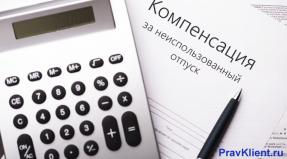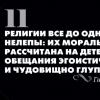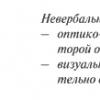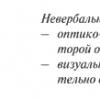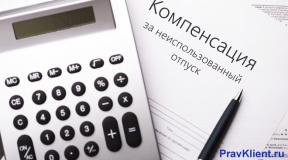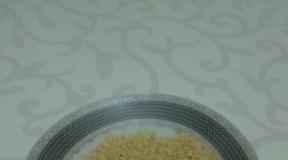The period after the parenthesis. Research of the market and internal environment of the organization Point after bracket or before
By adhering to accepted typing rules, you can significantly improve the appearance of the documents you create, whether for print or electronic publication.
How to enter text? When to use non-breaking spaces? Which symbol should I choose to represent a dash? Is there a space before and after a period? You will find answers to these and other questions in this article.
The letter “е” is written in the following cases:
- when it is necessary to prevent incorrect reading and understanding of a word, for example: let's find out Unlike let's find out; All Unlike All; bucket Unlike bucket; perfect(participle) in contrast to perfect(adjective);
- when you need to indicate the pronunciation of a little-known word, for example: Olekma River.
Units of measurement should be separated from the corresponding values by a non-breaking space (Alt + Num 0160).
For a dash (“Knowledge is power”) use an em dash (Alt + Num 0151). An em dash is separated from the preceding word by a continuous space, and from the following word by a regular space.
To indicate ranges (“3-5 kg”) and as a minus sign (“-32º C”), use an en dash (Alt + Num 0150). The en dash in ranges does not differ from the previous and subsequent values. The minus sign is not separated from the subsequent value, but is separated from the preceding word by an ordinary space.
The hyphen (“something”) is typed directly on the keyboard. The hyphen is part of the word and is not separated from preceding or following characters.
In the ranges, units of measurement are indicated only after the upper limit: “2670-2780 mm”. You should not duplicate units of measurement before the dash.
Abbreviations when referring to figures, tables, pages, etc., when indicated in the middle of a sentence, are written with a lowercase (small) letter: “Parking lights (see Fig. 1).” If an abbreviation is at the beginning of a sentence, it is written with a capital letter.
The numbers of the figures are formatted as follows: “Fig. 1. General view.” There is no period at the end of the signature. A period is also not put if the number of the figure and table is not accompanied by the signature: “Fig. 1".
In headings, only the first word should be capitalized, as in regular sentences. Do not capitalize all words in the title.
Periods are not placed at the end of headings (except for abbreviations).
Periods are not placed at the end of table cells (except for abbreviations).
Dots are not placed after abbreviations of standard units of measurement (SI): “150 m, 16 kg, 300 l.” Dots are also not placed after the abbreviations “million” and “billion” (but after “thousand” they are placed): “1 million”, but “23 thousand”. After abbreviations of units of measurement that are not standard, dots are added: “30 pcs., 12,000 rubles.”
The period after the abbreviation at the end of the sentence is not duplicated: “First, second, etc.” However, if an abbreviation with a period is enclosed in quotation marks or parentheses, a period is placed at the end of the sentence: “The complete set (8 pieces) must be installed.”
Punctuation marks dot (.), semicolon (;), comma (,), question mark (?), exclamation point (!), ellipsis (...) and colon (:) do not break away from the preceding text, but from the next one is separated by a space: “green, yellow, blue.”
As an ellipsis sign, you should use three separate period characters (when typing in Microsoft Word, you need to disable ellipsis autocorrect for this): “...”. When using an ellipsis together with a question mark or exclamation mark, these marks are placed first, and then two dots: “?..”. Ellipsis combined with interrogative And exclamation marks are typed in the following sequence: “?!.”.
Double spaces should be avoided in the text you type. To control the use of spaces in text when working in Microsoft Word, it is recommended to enable the mode for showing non-printing characters.
If an entire sentence (or several sentences) is enclosed in brackets, the period at the end of the sentence is placed inside the brackets: “Press the button Cancel. (If the data has been changed, the system will display a warning window.)." Otherwise, punctuation marks (if required) are placed after the closing bracket: “Select the required items (check the appropriate boxes).”
Only generally accepted abbreviations should be used.
In numbers with 5 or more digits, groups of digits are divided into threes and separated by non-breaking spaces (Alt + Num 0160): “35,000 rubles.” In four-digit numbers, division into groups is not made: “3200 pcs.”
When typing text, it is not allowed to use mixed registers, for example, instead of characters of the Russian alphabet, use characters of the Latin alphabet that are similar in style. This makes spell checking, searching, indexing, and other automated procedures difficult.
In Russian-language texts, the sign “№” (rather than “#”) should be used to indicate a number. The “No” sign is separated from the subsequent number by a non-breaking space: “No. 36”.
Only corner quotes should be used: " (Alt + Num 0171) and " (Alt + Num 0187). If necessary, you should use quotes like “ (Alt + Num 0147) and “ (Alt + Num 0148) as nested quotes: “Rainbow Project.” However, it is recommended to avoid nested quotes.
Only parentheses should be used as parentheses, regardless of nesting level. The parentheses are not separated from the text enclosed within them and are separated from external fragments, with the exception of punctuation marks: “The rent is 10,000 (ten thousand) US dollars”; "Press the button Exit(at the bottom of the dialog window), and then confirm saving the data."
In other cases, the letter “e” should be used.
What could be simpler marks at the end of a sentence!
Even in 1st grade, children learn to use a period, a question mark, or an exclamation mark. All!
However…
Difficulties arise when signs have to combine. Let's get a look.
Dot, ? And!
Let's remember the main rule:
There are NOT more than three characters in a row: … !.. ?.. ?!.
However, the rule only applies when combined different signs.
If we are talking about one thing, only the point has the privilege, and even then there should be exactly THREE(not two and no more than three), and this sign is called an ellipsis...
Ellipsis not separated by a space:
- at the beginning of a sentence - from the first word
- at the end of a sentence - from the last word
- inside a sentence - from a word, after which is worth
? And! There are only single ones.
That is, according to the rules, even two!! or three??? in a row - ERROR!
When combined ? And! are placed only in the following sequence: ?! And never vice versa.
Important! You can often see something like this inside a sentence: …, or ..,
Remember: ellipsis and comma DO NOT MATCH.
In such cases we simply set … and continue the sentence with a lowercase (as after a comma).
When a point collides abbreviations (and etc.) with a period at the end of the sentence there is an absorption: put only one dot: etc.
At the same time: if such an abbreviation at the end of the sentence is in brackets, a period is also placed after the bracket (like this: etc.).
Dot, dot, ? And! with "quotes" and (brackets)
What to do when the above-mentioned signs with quotation marks “collide” » or parenthesis ) ?
The rules are perfect different.
QUOTES
If a single word or several words are enclosed in quotation marks, everything is simple. Let us consider only the case when an offer is made entirely.
In this case … ! ? are placed INSIDE, but . always AFTER quotes. ALWAYS! ».
Note: the quote configuration does NOT matter.
BRACKETS
At first glance, everything is simpler with brackets. But there is a very important nuance here too.
Let's look only at the end of the sentence.
If enclosed in parentheses full offer- all signs (and a period too!) are placed inside:
The girl concentratedly placed punctuation marks. (The boy watched her expression.)
However, if only the parentheses include part of a sentence- everything changes radically:
signs are placed after the bracket.
The boy watched the expression on his friend’s face (she was putting punctuation marks).
Of course, we must not forget about cases when, for example, ? or ! refers to what is enclosed in brackets - it is clear that in this case they will be inside the brackets. However, there must still be a final sign that applies to the entire sentence. BEHIND the bracket.
You are following my train of thought (I’m talking about signs!)?
About headlines
Almost everyone knows that headlines don’t have a full stop. But when the title consists of two (or more) sentences - for some reason questions arise :)
So: in headings consisting of several sentences, a full stop is NOT placed after the last one! Don't believe me? Ask Milchin and Cheltsova...
_________________
Literature:
School textbook.
A. E. Milchin, L. K. Cheltsova.
_______________________________
EXERCISE
Make 9 sentences:
- Three - with a different combination of characters at the end of the sentence.
- Four - with different combinations of characters . … ? ! with quotes.
- One with parentheses inside a sentence (the one in parentheses must be at the end of the sentence).
- One sentence enclosed in parentheses.
Vladimir, you asked far from an idle question. The point is not a new fashion, but a certain vagueness of the old rules. If you follow the reference book by D.E. Rosenthal on spelling and style, there is no direct and unambiguous indication of whether it is necessary to put a period after the quotation marks closing direct speech, preceded by a question or exclamation mark. IN §119 the following is said:
It would seem that the paragraph indicates that a period is placed after the closing quotation mark. However, as we see, in the practical example from Lermontov there is no dot after the closing quotation mark. The same punctuation is used in other examples given in this paragraph.
Apparently, this sometimes confuses publishers.
However, in §135 Here is a rule that allows you to interpret the situation differently:
To be honest, I don’t see a fundamental difference between the example from Lermontov and the example about slogans on the sides of cars in terms of punctuation. Statements that there is direct speech, and here - something else, would be extremely far-fetched. After all, both there and here are direct reproductions of someone’s words (or text).
In conditions where the rules are not completely clear, I prefer to use common sense. A period is a punctuation mark that completes a declarative sentence. Let's compare two phrases:
(1) She asked me if I was hungry.
(2) She asked me: “Are you hungry?”
In both cases we are dealing with a declarative sentence of the form She asked me (something), and it is logical for this sentence to end with a period. The question mark refers to another phrase inserted into this sentence as a quotation, and it should not affect the punctuational completion of the main construction.
To summarize: in conditions of confusion, you need to give priority to logic. The absence of a period at the end of a declarative sentence that includes direct speech or a quotation deprives the sentence of completeness. Therefore, in such cases, I would still recommend putting an end to it, and if necessary, to justify this, refer to §135 of Rosenthal’s reference book, especially since the text of the instructions in §119 (except for the actual punctuation of the examples in this paragraph) does not formally contradict this.
11 simple rules that will help you learn how to create correct and readable lists anywhere: in presentations, reports, documents or on websites.
When drawing up documents, we often come across all sorts of lists. There are simple and multi-level lists. How to arrange them? When to use numbering, letters and dashes? When is it appropriate to end each list item with a period, and when is a comma or semicolon appropriate?
When drawing up documents, we often come across all sorts of lists. At the same time, there are a great many rules for their design. Let's try to understand them.
Notation of list elements
The pre-list sentence and the elements of the subsequent list (listed after the colon) can be written as a single line. But in long and complex lists, it is much more convenient to place each element on a new line. And here you have a choice: you can limit yourself to using paragraph indentation (Example 1) or replace it with a number, letter or dash (Example 2).
Example 1
Example 2

There are lists:
simple, those. consisting of one level of text division (see Examples 1 and 2) and
composite, including 2 or more levels (see Example 3).
The choice of symbols that will precede each element of the list depends on the depth of division. When creating simple lists, you can use lowercase (“small”) letters, Arabic numerals or dashes.
The situation is much more complicated with composite lists. For greater clarity combinations of different symbols In the lists we give an example of the design of a 4-level list:
Example 3

From this example it can be seen that the heading numbering system is as follows: the first level heading is designed using Roman numerals, the second level headings are using Arabic numerals without brackets, the third level headings are using Arabic numerals with brackets and, finally, the fourth level headings formatted using lowercase letters with brackets. If this list included another, fifth level, then we would design it using a dash.
Numbering system for parts of a composite list can only consist of Arabic numerals with dots. Then the structure of constructing the number of each element of the list reflects its subordination in relation to the elements located above (there is an increase in digital indicators):
Example 4

If at the end of the list there is “etc.”, “etc.” or “etc.”, then such text is not placed on a separate line, but is left at the end of the previous list element (see Examples 3 and 4).
Punctuation of lists
In Example 3 you can clearly see that the headings of the first and second levels begin with capital letters, and the headings of subsequent levels are from lowercase. This happens because after Roman and Arabic (without brackets) numerals, according to the rules of the Russian language, a dot is placed, and after the dot, as we all remember from elementary school, a new sentence begins, which is written with a capital letter. Arabic numerals with brackets and lowercase letters with brackets are not followed by a period, so the following text begins with a small letter. The last point, by the way, also applies to the dash, since it is difficult to imagine combining a dash with a dot after it.
pay attention to punctuation at the end
the headings of the list, as well as at the end of words and phrases in its composition.
If the title suggests subsequent division of the text, then a colon is placed at the end of it, but if there is no subsequent division, a period is placed.
Example 5

If parts of the list consist of simple phrases or one word, they are separated from each other by commas (see Example 5). If parts of the list are complicated (there are commas inside them), it is better to separate them with a semicolon (see Example 6).
Example 6
Finally, if parts of the list are separate sentences, they are separated from each other by a period:
Example 7

Sometimes the list is formatted in such a way that it is preceded by a whole sentence (or several sentences). In this case, the list uses only the so-called “lowest” levels of division (lowercase letters with a bracket or a dash), and dots are not placed at the end of each part of the list, because in this case, the list is a single sentence:
Example 8

It happens that some parts of the list that are phrases include an independent sentence starting with a capital letter. Regardless of the fact that according to the rules of the Russian language a period must be placed at the end of a sentence, each element of the list will be separated from the next by a semicolon:
Example 9

List Item Consistency
When compiling lists, you should always pay attention to the fact that the initial words of each element of the list are consistent with each other in gender, number and case. In Example 10 we presented a variant of incorrect formatting: the last element of the list is used in a different case compared to the rest. Errors like this usually occur in long lists with a large number of items.
Example 10

Also, all elements of the list must necessarily agree in gender, number and case with the words (or word) in the sentence preceding the list, followed by a colon. Let's look at the example of incorrect listing again to analyze the errors.
Example 11

This list may seem impeccable, if not for one “but”. The word “observance” requires words after it in the genitive case that would answer the questions “whom?” what?". Therefore, each section should begin like this:
So, we have given the basic rules for constructing and formatting lists that will help make your documents even more literate.
Read also...
- Research of the market and the internal environment of the organization The period is placed behind the bracket or before
- Research of the market and internal environment of the organization Point after bracket or before
- Changes in the simplified taxation system in the year
- Electronic invoices and reconciliation reports Correspondence with government agencies
